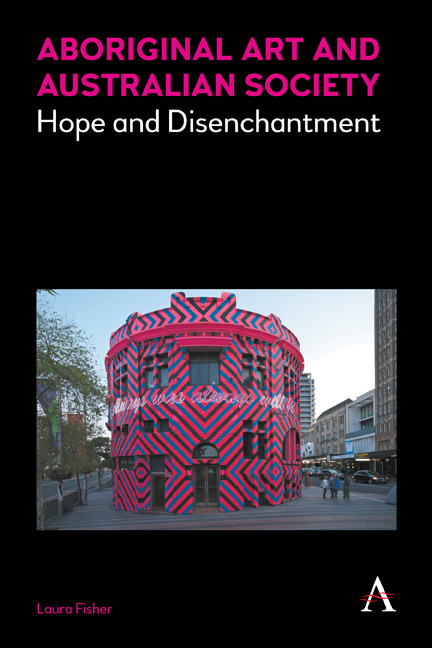Book contents
- Frontmatter
- Dedication
- Contents
- Preface and Acknowledgements
- Introduction
- Part I Governance, Nationhood and Civil Society
- Chapter 1 New Intercultural Relationships in the Post-Assimilation Era
- Chapter 2 Aboriginal People Mobilising Aboriginal Art
- Chapter 3 Understanding Aboriginal Art Subsidy
- Chapter 4 The State Mobilising Aboriginal Art
- Chapter 5 ‘Aboriginal Culture’ at the Nexus of Justice, Recognition and Redemption
- Part II Contemporary Aboriginal Art in the 1980s
- Part III Negotiating Difference
- Part IV Aboriginal Art, Money and the Market
- Conclusion
- Notes
- References
- Index
Chapter 2 - Aboriginal People Mobilising Aboriginal Art
from Part I - Governance, Nationhood and Civil Society
Published online by Cambridge University Press: 22 July 2017
- Frontmatter
- Dedication
- Contents
- Preface and Acknowledgements
- Introduction
- Part I Governance, Nationhood and Civil Society
- Chapter 1 New Intercultural Relationships in the Post-Assimilation Era
- Chapter 2 Aboriginal People Mobilising Aboriginal Art
- Chapter 3 Understanding Aboriginal Art Subsidy
- Chapter 4 The State Mobilising Aboriginal Art
- Chapter 5 ‘Aboriginal Culture’ at the Nexus of Justice, Recognition and Redemption
- Part II Contemporary Aboriginal Art in the 1980s
- Part III Negotiating Difference
- Part IV Aboriginal Art, Money and the Market
- Conclusion
- Notes
- References
- Index
Summary
There have been many cases in which Aboriginal people have used their art and material culture to pursue political agendas in the post-assimilation era. As we will see, Aboriginal art has played a powerful role in articulating Aboriginal land custodianship claims, in establishing a sense of Aboriginal collective identity or pan-Aboriginality and in defining the grievances and agendas that propelled urban Aboriginal activist movements. With respect to the triumvirate of relationships with which Part I is concerned (Indigenous people, the state and non-Indigenous citizens), the following will focus on the role of art in the Aboriginal community's efforts to communicate its demands to the state and non-Indigenous civil society.
Aboriginal Art Mobilised in Political and Legal Domains
On several occasions during the 1950s and 1960s when Aboriginal art was not yet securely ensconced within the Western category of art, the Yolngu of North East Arnhem Land mobilised their customary material culture (painted barks, sacred poles and sacred objects) to demonstrate to the Methodist missionaries who had jurisdiction over them the solidarity that existed between their clans, their sense of autonomy and the salience of their religion. They installed these objects – objects in which clan identities, land custodianship and law were symbolically inscribed – near or within the missionaries’ churches. In doing this, they were placing secret-sacred material in the public domain in an unprecedented way (Morphy 1983). During these and later years, they also presented paintings ceremonially to visiting representatives of the church, members of parliament, lawyers and police. In a much more famous example, the Yolngu of the settlement of Yirrkala presented a petition to the House of Representatives of the Federal Parliament in 1963 in response to the announcement that large tracts of their traditional country were to be excised for lease by the Nabalco Mining Company. Previously of no value to settler interests, the area had been found to be rich in bauxite. The petition, typed out in both a Yolngu language and English, was signed by clan leaders and affixed to a length of bark on which sacred clan designs painted in ochre created a border for the printed page.
- Type
- Chapter
- Information
- Aboriginal Art and Australian SocietyHope and Disenchantment, pp. 31 - 40Publisher: Anthem PressPrint publication year: 2016



